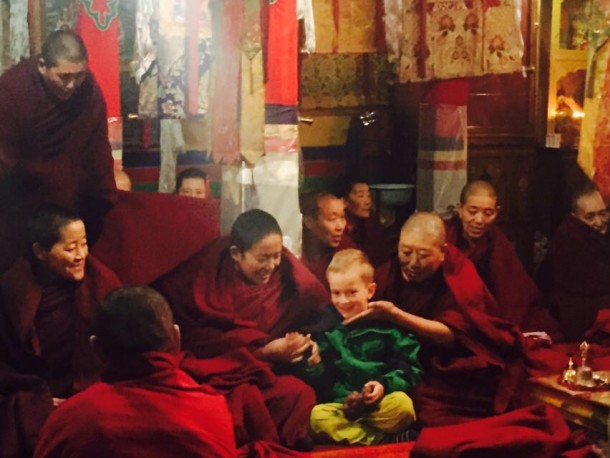
Garu La Nunnery-Tibet.

This recent reconstructed nunnery is situated on a low crest to the north of the northernmost ramparts of the wall surrounding the monastic complex of Gyantse. It is reached by driving out of the old town, going around the castle,then swinging back toward the monastic complex. The ruins of a nunnery called Rinchen Khang,dating back to the time of the Empire,can be seen about a kilometer from the site of the present nunnery,on the crest of a foothill to the north-north-east. It used to house seventy nuns but was destroyed during the cultural revolution. The reason for the change in location is as follows. sometime in the latter part of the nineteenth century a monk called Gelong Obar wanted to build a stupa and asked a Lama where the best place would be. The lama answered crytically:”The elephant will tell you.” Three years later the Panchen Lama received an elephant as a gift from India,Which he kept near Gyantse. One day the animal escaped and ran into the nearby hills,where he rolled on the ground and bellowed three times. Gelong Obar realized that this was where he should build this stupa. Although the original stupa was destroyed during the cultural revolution,it was rebuilt in 1986 and the nunnery gradually erected beside it. The main image in the assembly hall is an eleven-headed,eight-armd Avaoliteshvara,flanked by Manjushri and Vajrapani. Although the thrity nuns here are of Gelek tradtition,the image of Tangtong Gyelpo and Milarepa in the assembly hall and the statue of Padmasambhava in the main stupa indicate a nonsextatian emphasis. The nuns are under the direction of an abbot from Pelkor Chode. Beside the main stupa are two smaller stupas,one dedicated to world peace with an image of Shakyamuni, the other a victory stupa, In the cliff face behind the nunnery a number of reconstructed hermitages are visible,one of which was where Gelong Obar himself meditated. A sky burial site can also be seen from here.
Recent Posts
Top 5 Most Asked questions on Tibet Travel
7 Tips for a Successful Trip to Tibet
A Journey to Everest Base Camp in Tibet
All Categories
- About Tibet
- book a Tibet tour
- Buddhism Practice
- Budget Tour
- China-Tibet Train
- Customized Tibet tour
- Historical Sites
- Hot Springs in Tibet
- News
- Photography in Tibet
- Tibet attraction
- Tibet Group Visa
- Tibet Motorcycle Tour
- Tibet Small Group Tours
- Tibet Tours and Tibetan Tour Guide
- Tibet Train
- Tibet Travel FAQs
- Tibet Travel Information
- Tibet Travel News
- Tibet Travel Permit Update
- Tibet Travel Prices Rises
- Tibet Trek
- Tibet Trekking Tour
- Tibet weather and climate
- Tibet Wildlife animals
- Tibet Winter Tour
- Tibetan Buddhism
- Tibetan Cultural Features
- Tibetan Culture and Poeple
- Tibetan Festivals
- What to see in Tibet


